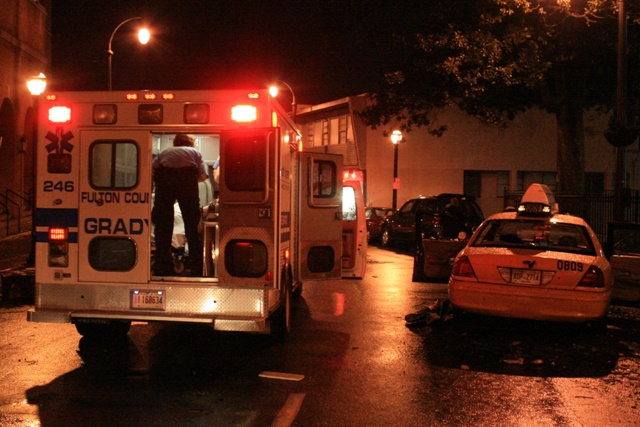
(Ildar Sagdejev, Wikimedia Commons. https://commons.wikimedia.org/wiki/File:2008-03-14_Ambulance_on_Luckie_St.jpg)
28 July 2023. The U.S. Food and Drug Administration issued new regulatory guidance for clinical trials of medical devices designed to prevent or treat opioid use disorder. The agency released the draft document in the Federal Register for 90 days seeking public comments, outlining issues regulators want to see addressed in clinical studies of medical devices offering help for people with opioid use disorder.
The opioid crisis in the U.S. continues with deaths from drug overdoses increasing over the past 20 years, and accelerating since 2013. The recent jump in overdose deaths can be traced to synthetic opioid compounds such as fentanyl. Center for Disease Control and Prevention says synthetic opioids have largely replaced prescription pain drugs and heroin among people with drug overdoses. In one year, from 2019 to 2020 says CDC, deaths from prescription opioids and heroin rose 17 percent and 7 percent respectively, while overdose deaths from fentanyl and other synthetic opioids rose 56 percent.
While medications such as naloxone are being fast-tracked in regulatory reviews as a rescue drug for opioid overdose — FDA today also approved a second non-prescription/over-the-counter naloxone nasal spray — the agency is also encouraging medical device developers to address the problem. For example, in 2018, FDA began a challenge competition for medical devices to help people deal with opioid addictions, resulting in more than 250 responses and eight finalists with technologies for diagnostics, monitoring, therapies for opioid use disorder or alternative pain treatments, and medication dispensing.
Follow-up periods of at least six months
The new FDA guidance seeks to spell out key issues for developers designing clinical trials assessing their medical devices to prevent or treat opioid use disorder. Diagnostics and alternative pain treatments are outside the document’s scope. In testing the efficacy of therapy devices, the guidance recommends developers use sham devices, replicas of test symptoms with therapeutic actions removed, in comparison or control groups. The document also recommends follow-up periods of at least six months, due to risks of relapse among study populations, as well as taking steps to retain trial participants and account for missing data.
FDA proposes medical device developers employ tight assessments of trial participant drug use in clinical trials, both prescribed and non-prescribed drugs. While participants may be asked to self-report on their drug use during clinical trials, the guidance recommends device developers also run scheduled and random drug tests with urine or other fluid samples. Changes in drug use patterns are often primary indicators of efficacy, says the agency, thus reductions in drug use should be measured and reported as sample percentages, not as group averages.
When designing primary efficacy indicators, says FDA, developers should use criteria for describing symptoms of moderate to severe opioid use disorder, as defined in the latest (5th edition) of the Diagnostic and Statistical Manual of Mental Disorders, published by American Psychiatric Association. And the document calls for efficacy measures to include rates of adverse outcomes, such as need for emergency medical attention, incidence of hepatitis C common among drug users sharing needles, and participant deaths.
“We are committed to helping industry develop solutions that are proven to be effective to address the devastation caused by the overdose crisis,” says FDA commissioner Robert Califf in an agency statement. “This draft guidance for device studies should prompt industry to collect more comprehensive, timely, and diverse data to support device submissions that may help improve the lives of those with opioid use disorder.”
More from Science & Enterprise:
- Low-Dose Oral Film Reduces Mental Disorder Agitation
- Brain-Computer Device Company Gains $33M in Early Funds
- Trial to Test Low-Dose Psilocybin for Mental Distress
- Standard Electronic Biomarkers Validated for Schizophrenia
- Over-the-Counter Naloxone Receiving Faster FDA Review
We designed Science & Enterprise for busy readers including investors, researchers, entrepreneurs, and students. Except for a narrow cookies and privacy strip for first-time visitors, we have no pop-ups blocking the entire page, nor distracting animated GIF graphics. If you want to subscribe for daily email alerts, you can do that here, or find the link in the upper left-hand corner of the desktop page. The site is free, with no paywall. But, of course, donations are gratefully accepted.
* * *

 RSS - Posts
RSS - Posts
You must be logged in to post a comment.